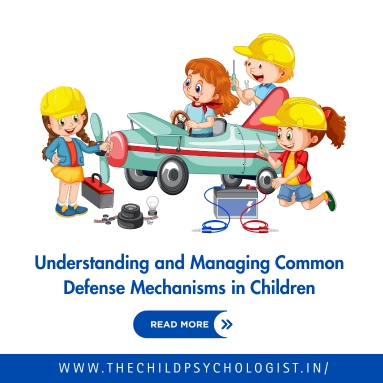By Dr. Vini Jhariya | Child & Clinical Psychologist | Founder, Urjasvini Child Development Center, Indore
Emotional Defense Isn’t Misbehavior
Just like adults, children face stress, anxiety, and emotional challenges — but they often lack the vocabulary to express what they feel. Instead, they unconsciously use defense mechanisms to cope. These are not signs of “bad behavior” but protective strategies developed by a child’s mind to manage emotional discomfort.
At Urjasvini Child Development Center, our approach to counselling for child behaviour focuses on identifying these subtle signs and offering age-appropriate ways to help children express themselves in healthier ways.
Why Understanding Defense Mechanisms Matters
Defense mechanisms are part of a child’s emotional survival toolkit. When understood early, they can be redirected into healthier behaviors, building a strong foundation for:
- Emotional resilience
- Improved communication
- Better self-regulation
- Long-term psychological well-being
If you are a parent looking for child counselling in Indore, recognizing these behaviors is the first step toward supporting your child’s emotional health.
15 Common Defense Mechanisms in Children — and What They’re Communicating
1. Denial
“I didn’t do it!”
Refusing to accept reality to avoid emotional discomfort.
Tip: Validate their emotions first, then guide them gently toward responsibility.
2. Regression
Behaviors like thumb-sucking or bed-wetting occur after starting school.
Tip: Offer comfort and avoid punishment. Regression is often triggered by stress or insecurity.
3. Acting Out
Tantrums, aggression, or loud outbursts when feeling helpless.
Tip: Help them identify their feelings: “You’re angry because your toy broke.”
4. Dissociation
Zoning out or seeming emotionally “numb” during stress.
Tip: Use calming routines and grounding exercises to help them reconnect.
5. Projection
“You’re mad at me!” — when they’re feeling angry themselves.
Tip: Teach emotional awareness and model honest self-expression.
6. Rationalization
“I didn’t want to win anyway.”
Used to protect self-esteem after a disappointment.
Tip: Praise their effort and show that failure is a part of growth.
7. Fantasy
Escaping into imaginary stories to cope with stress.
Tip: Encourage creativity but also talk through real-life concerns gently.
8. Displacement
Taking out anger on toys, pets, or siblings.
Tip: Provide safe emotional outlets like drawing or physical activity.
9. Undoing
“I’ll be really good now!” after misbehavior.
Trying to “cancel” guilt through extra kindness.
Tip: Focus on learning from mistakes, not compensating for them.
10. Repression
Forgetting upsetting experiences, like a bad day at school.
Tip: Stay observant and create space for emotional sharing over time.
11. Identification
Mimicking parents, superheroes, or strong peers to feel more in control.
Tip: Encourage positive role models and celebrate unique traits.
12. Introjection
“I’m so stupid” — absorbing others’ criticism as truth.
Tip: Rebuild confidence through consistent encouragement and praise.
13. Withdrawal
Avoiding social situations due to anxiety or low confidence.
Tip: Gently reintroduce social settings and respect their emotional pace.
14. Compensation
“I’m not good at reading, but I’m great at drawing!”
Balancing perceived weaknesses with strengths.
Tip: Celebrate both their efforts and talents equally.
15. Reaction Formation
Being overly kind or cheerful to cover up anger or fear.
Tip: Reassure them that all feelings — even difficult ones — are valid and safe to share.
How Parents Can Support Emotional Growth
- Validate Their Emotions
Say things like, “It’s okay to be upset — let’s talk about it.”
- Name the Behavior Gently
Try: “It looks like you’re pretending to be okay, but I wonder if you’re feeling sad.”
- Offer Healthier Outlets
Journaling, drawing, storytelling, or play therapy are great tools.
- Be Consistent
Create routines that make your child feel safe and emotionally secure.
- Model Emotional Expression
Say things like, “I felt worried today, so I talked to someone about it.”
Defense mechanisms are a normal part of emotional development. When recognized with care and compassion, they become growth opportunities, not punishment. As parents, educators, or caregivers, we can gently guide children toward emotional strength and self-awareness.
If you’re concerned about your child’s emotional behavior or coping strategies, working with a psychological counsellor in Indore can be a valuable step.
